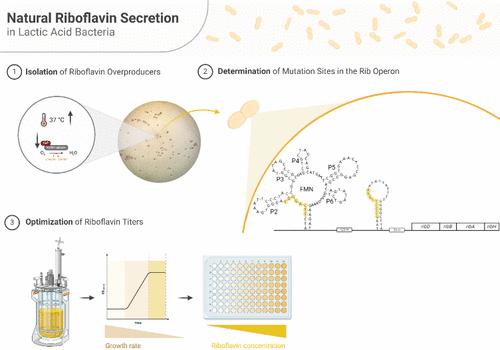利用氧化应激获取可分泌天然核黄素的乳酸菌用于生物强化
IF 5.7
1区 农林科学
Q1 AGRICULTURE, MULTIDISCIPLINARY
引用次数: 0
摘要
在高温条件下,乳酸乳球菌会因溶解氧而遭受氧化应激和核黄素饥饿。在此,我们探讨了能否利用这一现象获得核黄素过量产生的突变体。利用核黄素辅助营养型乳酸菌株作为核黄素生物传感器,我们筛选了暴露在温度诱导的氧化应激下长达一年的乳酸菌培养物。核黄素分泌突变体很容易被识别出来,其中一些突变体在暴露于氧化应激仅两周后就出现了。全基因组测序发现了核糖开关的突变,该开关能调节核黄素的生物合成。核黄素的分泌显著增强了对氧化应激的耐受性,并使其能够在有溶解氧的高温条件下生长。随后的研究证明,在高温(37 °C)下剧烈通气可促使核黄素分泌突变体迅速出现。核黄素对氧化应激的保护作用可以解释为什么天然乳酸菌(LAB)会分泌核黄素。通过优化发酵条件和消除乳酸盐的形成,我们获得了 64 mg/L 的核黄素,这是迄今为止报道的乳酸菌的最高滴度,这表明核黄素在食品中用作核黄素强化剂的巨大潜力。本文章由计算机程序翻译,如有差异,请以英文原文为准。

Harnessing Oxidative Stress to Obtain Natural Riboflavin Secreting Lactic Acid Bacteria for Use in Biofortification
Lactococcus lactis suffers from oxidative stress and riboflavin starvation at elevated temperatures due to dissolved oxygen, which can be relieved partially by exogenously supplied riboflavin. Here we explore whether this phenomenon can be harnessed to obtain riboflavin overproducing mutants. Using a riboflavin auxotrophic L. lactis strain as a riboflavin biosensor, we screened L. lactis cultures that had been exposed to temperature induced oxidative stress for up to one year. Riboflavin secreting mutants could readily be identified, some of which had arisen after just two weeks of exposure to oxidative stress. Whole genome sequencing revealed mutations in the riboswitch, which regulate riboflavin biosynthesis. Riboflavin secretion conferred a significant increase in tolerance to oxidative stress and enabled growth at high temperatures in the presence of dissolved oxygen. It was subsequently demonstrated that vigorous aeration at high temperature (37 °C) could prompt rapid emergence of riboflavin secreting mutants. The protective effect provided by riboflavin against oxidative stress may explain the natural occurrence of lactic acid bacteria (LAB) secreting riboflavin. By optimizing fermentation conditions and eliminating lactate formation, we achieved 64 mg/L riboflavin, the highest reported titer so far for LAB, which indicates great potential for use as a riboflavin fortification agent in food.
求助全文
通过发布文献求助,成功后即可免费获取论文全文。
去求助
来源期刊
CiteScore
9.90
自引率
8.20%
发文量
1375
审稿时长
2.3 months
期刊介绍:
The Journal of Agricultural and Food Chemistry publishes high-quality, cutting edge original research representing complete studies and research advances dealing with the chemistry and biochemistry of agriculture and food. The Journal also encourages papers with chemistry and/or biochemistry as a major component combined with biological/sensory/nutritional/toxicological evaluation related to agriculture and/or food.

 求助内容:
求助内容: 应助结果提醒方式:
应助结果提醒方式:


